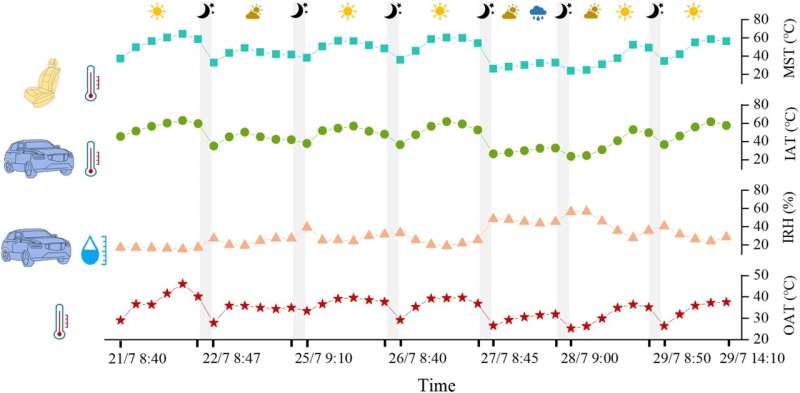This article has been reviewed according to Science X's editorial process and policies. Editors have highlighted the following attributes while ensuring the content's credibility:
fact-checked
peer-reviewed publication
proofread
New car smell reaches toxic levels on hot days, researchers find

A study of volatile organic compounds (VOCs) emitted by new cars on hot summer days finds concerning levels of formaldehyde and other aldehydes.
Consumers are familiar with—and even drawn to—the "new car smell" produced as VOCs from carpets, upholstery, and other interior materials in newly manufactured passenger vehicles. These VOCs can cause a range of health effects, including headaches, inflammation of the eyes, nose and throat, fatigue, irritability, dry cough, lung disease, and disorientation.
Jianyin Xiong, Shaodan Huang, and colleagues sought to capture the levels of VOCs in the passenger cabins of new cars on hot summer days given that climate change is increasing summer temperatures globally. Data from several hot summer days, with outside air temperatures of 25.3 °C– 46.1 °C (77.5 °F–115 °F), showed high levels of formaldehyde, acetaldehyde, and hexaldehyde.
The study is published in the journal PNAS Nexus.
The Chinese national concentration limit for formaldehyde in passenger vehicle cabins is 100 μg/m3. The authors found levels in the experimental car sometimes exceeding 200 μg/m3. The national limit for acetaldehyde is 50 μg/m3. Levels in the experimental car could reach 140 μg/m3.
A machine learning model of the data identified material surface temperature as the most important influence on in-cabin VOC concentrations. The authors produced a deep learning model to predict the concentrations of 12 typical VOCs in passenger vehicle cabins.
According to the authors, the model could be used for in-cabin concentration prediction and exposure assessment, which could be integrated with the control system of intelligent cars.
More information: Zhang R. et al. Cabin air dynamics: Unraveling the patterns and drivers of volatile organic compound distribution in vehicles, PNAS Nexus (2024). DOI: 10.1093/pnasnexus/pgae243. academic.oup.com/pnasnexus/art … /3/7/pgae243/7717707
Journal information: PNAS Nexus
Provided by PNAS Nexus




















